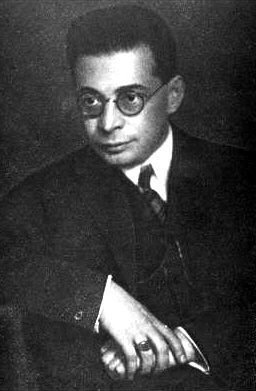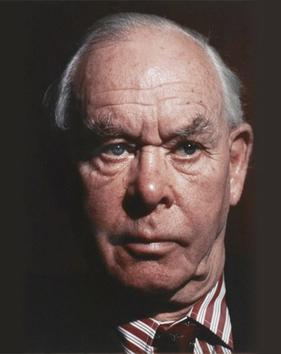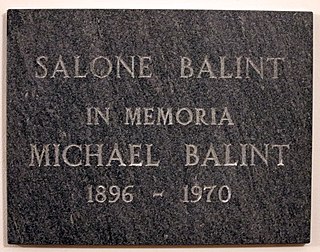Related Research Articles

Jacques Marie Émile Lacan was a French psychoanalyst and psychiatrist. Described as "the most controversial psycho-analyst since Freud", Lacan gave yearly seminars in Paris from 1953 to 1981, and published papers that were later collected in the book Écrits. His work made a significant impact on continental philosophy and cultural theory in areas such as post-structuralism, critical theory, feminist theory and film theory, as well as on the practice of psychoanalysis itself.
Psychoanalysis is a set of theories and therapeutic techniques that deal in part with the unconscious mind, and which together form a method of treatment for mental disorders. The discipline was established in the early 1890s by Sigmund Freud, whose work stemmed partly from the clinical work of Josef Breuer and others. Freud developed and refined the theory and practice of psychoanalysis until his death in 1939. In an encyclopedia article, he identified the cornerstones of psychoanalysis as – "the assumption that there are unconscious mental processes, the recognition of the theory of repression and resistance, the appreciation of the importance of sexuality and of the Oedipus complex." Freud's students Alfred Adler and Carl Gustav Jung developed offshoots of psychoanalysis which they called individual psychology (Adler) and Analytical Psychology (Jung), although Freud himself wrote a number of criticisms of them and emphatically denied that they were forms of psychoanalysis. Psychoanalysis was later developed in different directions by neo-Freudian thinkers, such as Erich Fromm, Karen Horney, and Harry Stack Sullivan.

Otto Rank was an Austrian psychoanalyst, writer, and philosopher. Born in Vienna, he was one of Sigmund Freud's closest colleagues for 20 years, a prolific writer on psychoanalytic themes, editor of the two leading analytic journals of the era, managing director of Freud's publishing house, and a creative theorist and therapist. In 1926, Rank left Vienna for Paris and, for the remainder of his life, led a successful career as a lecturer, writer, and therapist in France and the United States.

Donald Woods Winnicott was an English paediatrician and psychoanalyst who was especially influential in the field of object relations theory and developmental psychology. He was a leading member of the British Independent Group of the British Psychoanalytical Society, President of the British Psychoanalytical Society twice, and a close associate of Marion Milner.
Prenatal psychology can be seen as a part of developmental psychology, although historically it was developed in the heterogenous field of psychoanalysis. Its scope is the description and explanation of experience and behaviour of the individual before birth and postnatal consequences as well. In so far as the actual birth process is involved one can consider this perinatal psychology. Pre- and perinatal aspects are often discussed together.
Object relations theory is a school of thought in psychoanalytic theory centered around theories of stages of ego development. Its concerns include the relation of the psyche to others in childhood and the exploration of relationships between external people, as well as internal images and the relations found in them. Thinkers of the school maintain that the infant's relationship with the mother primarily determines the formation of its personality in adult life. Particularly, attachment is the bedrock of the development of the self or the psychic organization that creates the sense of identity.

Edward John Mostyn Bowlby, CBE, FBA, FRCP, FRCPsych was a British psychologist, psychiatrist, and psychoanalyst, notable for his interest in child development and for his pioneering work in attachment theory. A Review of General Psychology survey, published in 2002, ranked Bowlby as the 49th most cited psychologist of the 20th century.
A comfort object, more formally a transitional object or attachment object, is an item used to provide psychological comfort, especially in unusual or unique situations, or at bedtime for children. Among toddlers, a comfort object often takes the form of a blanket or a stuffed animal toy or some other favorite toy, and may be referred to by a nickname such as blankie.
Anal eroticism, in psychoanalysis, is sensuous pleasure derived from anal sensations. Sigmund Freud, the founder of psychoanalysis, hypothesized that the anal stage of childhood psychosexual development was marked by the predominance of anal eroticism.

Michael Balint was a Hungarian psychoanalyst who spent most of his adult life in England. He was a proponent of the Object Relations school.
Henry James Samuel Guntrip was a British psychologist known for his major contributions to object relations theory or school of Freudian thought. He was a Fellow of the British Psychological Society and a psychotherapist and lecturer at the Department of Psychiatry, Leeds University, and also a Congregationalist minister. He was described by Dr Jock Sutherland as "one of the psychoanalytic immortals".
In the theory of Jacques Lacan, demand represents the way instinctive needs are inevitably alienated through the effects of language on the human condition. The concept of demand was developed by Lacan in parallel to those of need and desire to account for the role of speech on human aspirations. Demand forms part of Lacan's battle against the approach to language acquisition favored by ego psychology, and makes use of Kojeve's theory of desire. Demand is not a Freudian concept.
Love and hate as co-existing forces have been thoroughly explored within the literature of psychoanalysis, building on awareness of their co-existence in Western culture reaching back to the “odi et amo” of Catullus, and Plato's Symposium.
The true self and the false self are a psychological dualism conceptualized by English psychoanalyst Donald Winnicott. Winnicott used "true self" to denote a sense of self based on spontaneous authentic experience and a feeling of being alive, having a real self with little to no contradiction. "False self", by contrast, denotes a sense of self created as a defensive façade, which in extreme cases can leave an individual lacking spontaneity and feeling dead and empty behind an inconsistent and incompetent appearance of being real, such as in narcissism.
Neville Symington was a member of the Middle Group of British Psychoanalysts which argues that the primary motivation of the child is object-seeking rather than drive gratification. He published a number of books on psychoanalytic topics, and was President of the Australian Psychoanalytical Society from 1999 to 2002.
In psychology, narcissistic withdrawal is a stage in narcissism and a narcissistic defense characterized by "turning away from parental figures, and by the fantasy that essential needs can be satisfied by the individual alone". In adulthood, it is more likely to be an ego defense with repressed origins. Individuals feel obliged to withdraw from any relationship that threatens to be more than short-term, avoiding the risk of narcissistic injury, and will instead retreat into a comfort zone. The idea was first described by Melanie Klein in her psychoanalytic research on stages of narcissism in children.
Counterphobic attitude is a response to anxiety that, instead of fleeing the source of fear in the manner of a phobia, actively seeks it out, in the hope of overcoming the original anxiousness.
Lacanianism or Lacanian psychoanalysis is a theoretical system that explains the mind, behaviour, and culture through a structuralist and post-structuralist extension of classical psychoanalysis, initiated by the work of Jacques Lacan from the 1950s to the 1980s. Lacanian perspectives contend that the world of language, the Symbolic, structures the human mind, and stress the importance of desire, which is conceived of as endless and impossible to satisfy. Contemporary Lacanianism is characterised by a broad range of thought and extensive debate between Lacanians.
Psychodynamic Therapy with Infants and Parents aims to relieve emotional disturbances within the parent(s), the baby, and/or their interaction, for example, postnatal depression and anxiety, infant distress with breastfeeding and sleep, and attachment disorders. It rests on attachment theory and psychoanalysis. Sigmund Freud suggested that a modification of his method could be applied to children, and child analysis was introduced in the 1920s by [Anna Freud].., [Melanie Klein], and Hermine Hug von Hellmuth. Klein speculated on infantile experiences to understand her patients' disorders but she did not practice PTIP. Donald Winnicott, a pediatrician and analyst, focused on the mother-baby interplay in his theorizing and his brief parent-child consultations, but he did not work with PTIP.
Patrick Casement is a British psychoanalyst and author of multiple books and journal articles on contemporary psychoanalytic technique. He has been described as a pioneer in the relational approaches to psychoanalysis and psychotherapy by Andrew Samuels, Professor of Analytical Psychology. His book 'Learning from Our Mistakes' received a Gradiva award for its contribution to psychoanalysis, and his book 'Learning Along the Way: Further Reflections on Psychoanalysis and Psychotherapy' was listed in the top 100 psychotherapy books of all time by Bookauthority.
References
- ↑ J. Kristeva, Melanie Klein (2013) p. 185
- ↑ A. Akhtar, Comprehensive Dictionary of Psychoanalysis (2009) p. 43
- ↑ D. W. Winnicott, The Child, the Family and the Outside World (1973) p. 28 and p. 146
- ↑ P. Casement, Further Learning from the Patient (1990) p. 161-2
- ↑ J. Fiscalini, Coparticipant Psychoanalysis (2012) p. 162-3
- ↑ A. Green, On Private Madness (1996) p. 327